6 Common House Plant Pests and How to Get Rid of Them
Apr 18, 2022
House plant pests can come from anywhere—an open window, clothing, a new plant, or house plants summered outdoors and brought inside without being pre-cleaned. When conditions areideal for pests and natural predators are absent house plant pests will flourish and populations will boom if left unchecked. For this reason, it is essential to know the most common pests, where to find them, and how to quickly and effectively eradicate them.
As soon pests are spotted, establishing an integrated pest management (IPM) program is the best way to stop them quickly. A good IPM program requires understanding the pest, its life cycle, and the best ways to kill it using practical, organic methods.
Keep plants in good health as pre-emptive protection (stressed plants emit stress hormones that attract pests), check and clean new plants before introducing them to the home, and clean plants regularly. Even with the best care, pests happen. The list below includes the six most common house plant pests, how to spot them, and effective ways to manage them. All of these pests attack a wide variety of common house plants.
Common House Plant Pests
1. Aphids
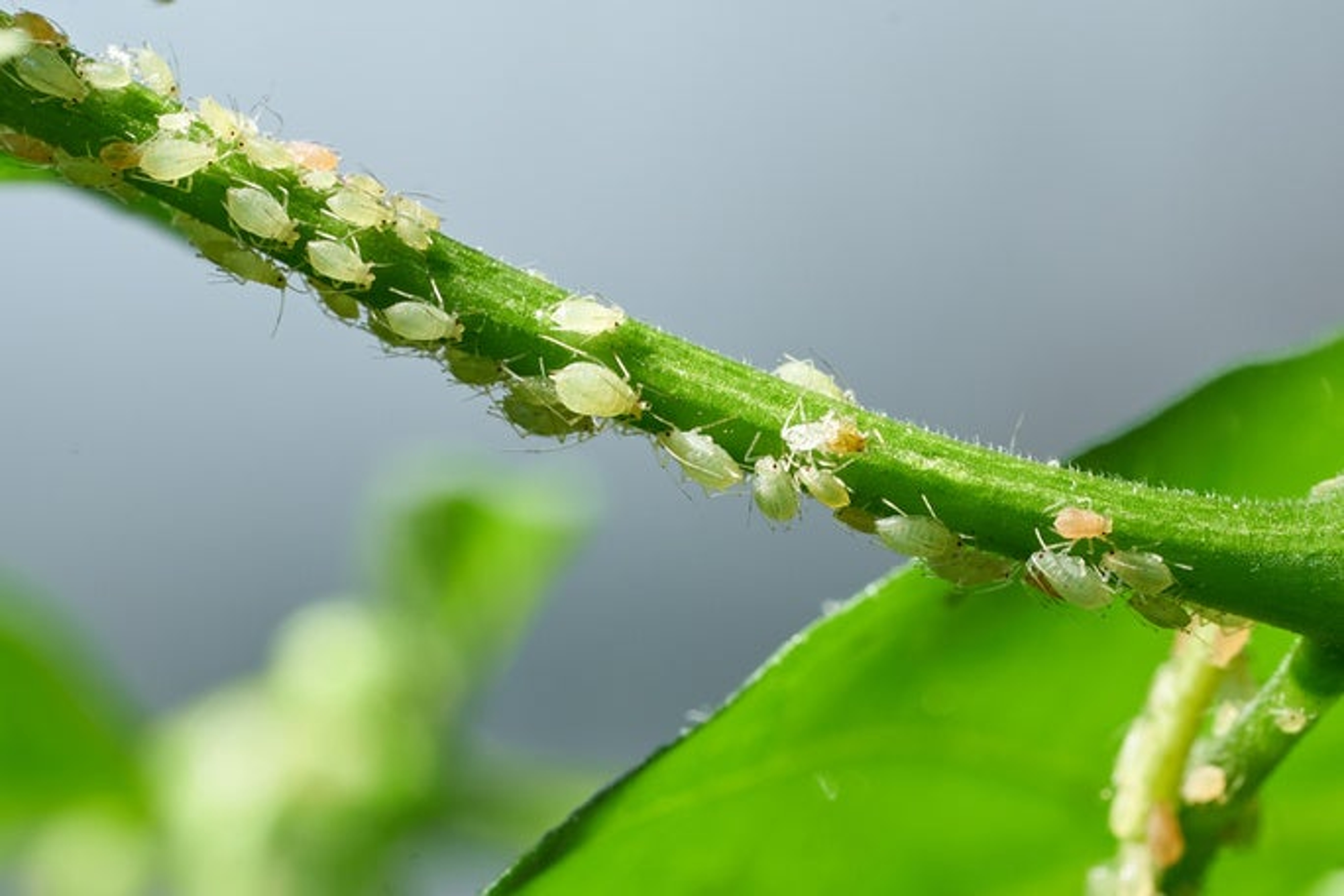
Identification (nymphs and adults): The adults are small, reaching 2-4 mm, and may be translucent green, yellow, red, or brown. They have fine, stick-like legs and bulbous bodies. Females may be winged and bear both eggs and live nymphs. Aphid nymphs look like smaller versions of adults and reach reproductive maturity just eight days after birth. Aphid eggs are elliptical and appear on leaf undersides. These should be scraped off or the leaves removed on sight.
Damage and Location: These sucking insects have tube-like mouthparts used to suck the juices from healthy leaves and stems—often at the growing points. They excrete a trail of sweet, sticky honeydew that attracts ants. Infested leaves often drop. High populations can reduce fruiting and flowering and cause general decline.
Management: Aphids are easy to kill. The fragile insects can be washed off using a spray of tap water in the sink or tub. Follow up by wiping off any stragglers with a damp cloth. Let the leaves and stems dry, and then spray with an insecticidal soap that bears the OMRI Listed® seal, which means it is approved for organic gardening. Check the soil surface to make sure none have fallen to the base of the plant, and spray with more insecticidal soap if they have. Continue to check and treat at watering time until there are no signs of aphids.
Notes: Aphid infestations encourage the foliar-disease, black sooty mold.
2. Fungus Gnats
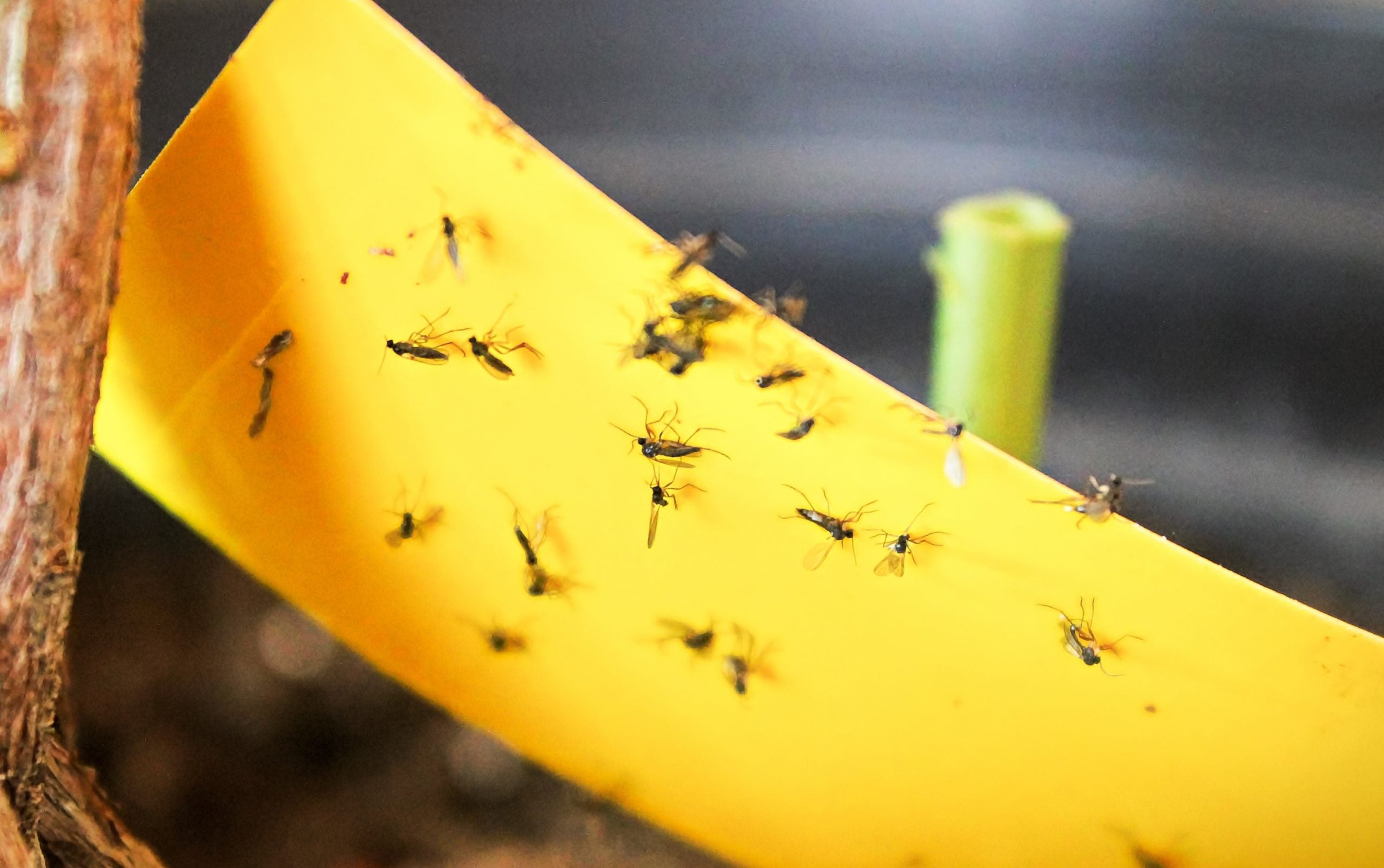
Identification (eggs, larvae, and adults): The adults are tiny, dark, winged flies (4 mm). They lay tiny, clear eggs on the surface of wet or moist soils. The eggs hatch into tiny maggots that create a sheen on the soil where they feed. The larvae hatch, feed, and pupate within just 17 days, so act fast when you first see fungus gnats.
Damage and Location: The larvae feed on roots, algae, fungus, and moist organic matter in the first 1 to 1.5 inches of surface soil. The root-eating larvae are most harmful to small plants and seedlings.
Management: Wet soil is the chief fungus-gnat attractant. As a first management step, allow the soil surface to become dry between watering. You may also consider bottom watering to avoid surface moisture. Another tool is to top the soil surface with an inorganic cover, like pebbles, coarse sand, chicken grit, or diatomaceous earth. (Some swear by the gnat-killing power of diatomaceous earth!) In extreme cases, soil surfaces can be treated with pyrethrin spray when many larvae are visible. Adult populations can be determined and managed using yellow sticky traps, which trap and kill them.
Note: Fungus gnats spread the fungal diseases that cause seedling damping off and plant root rot, Pythium and Phytophthora.
3. White Flies
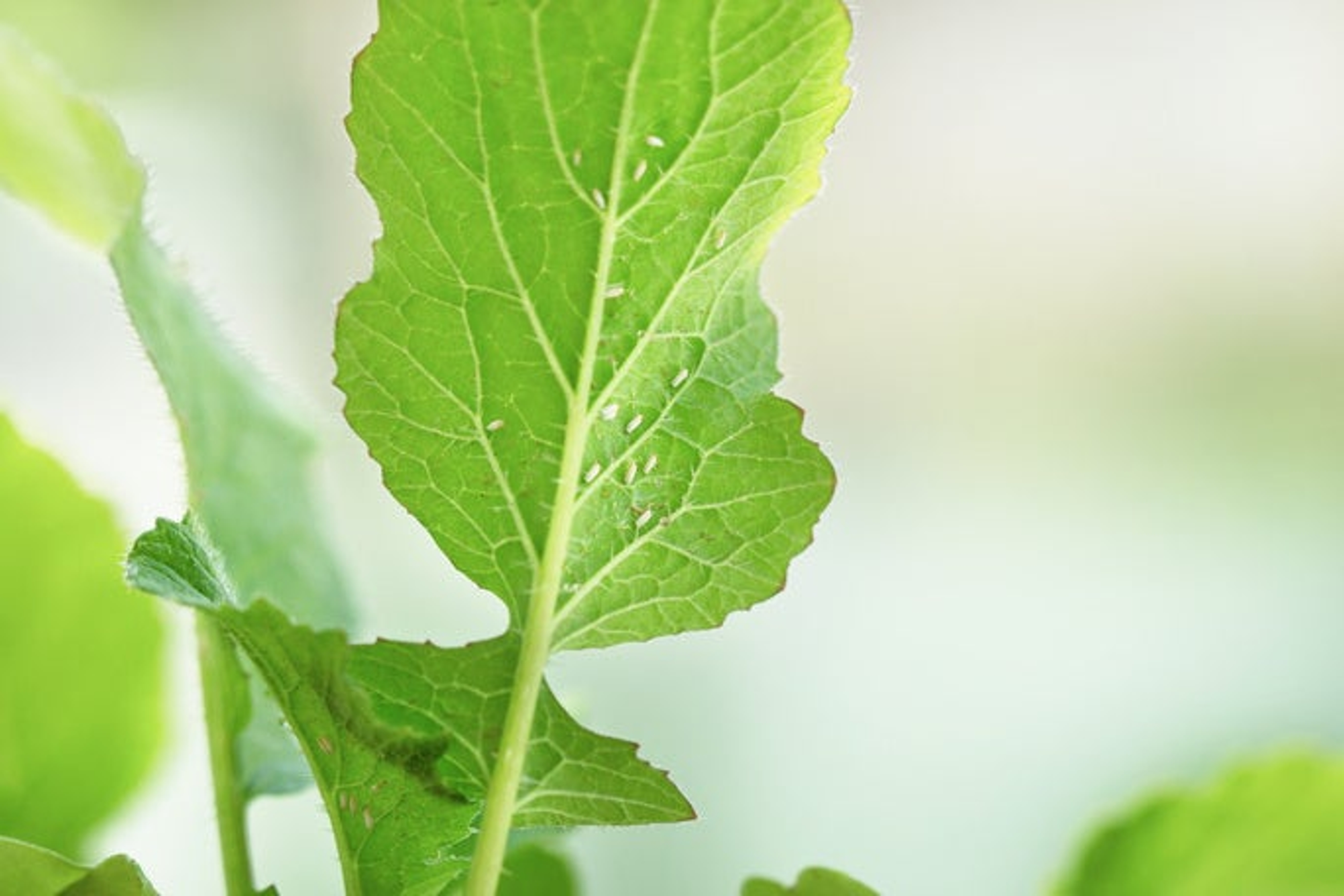
Identification (eggs, nymphs, and adults): Whiteflies lay clusters of tiny, white eggs on the undersides of leaves. Six days after being laid, they hatch into microscopic crawlers that latch onto the leaf tissue, start sucking and remain immobile. They grow to larger nymphs, become encased (much like a scale insect), and metamorphose into tiny, bright white flies. They complete a single life cycle—from hatching to adult— in only 30 days.
Damage and Location: Whiteflies are piercing, sucking insects that have tube-like mouthparts used to suck the juices from healthy leaves and stems. They are most often found on leaf undersides. Like aphids, they leave behind a sticky residue. Populations grow quickly and when they are high, they cause terrible plant damage that results in leaf drop and general decline.
Management: Leaf undersides can become covered with clouds of tiny, destructive white flies, nymphs and egg masses fast if they are not managed quickly. If you find them, remove the most infested leaves, especially those with egg masses and nymphs. Bag and dispose of them. Next, check all surrounding plants. Spray , wash, and wipe down all plant leaves and stems with insecticidal soap, if possible. Lightly scrape off egg masses that are not numerous. Follow up by spraying the plants with insecticidal soap or Neem oil. Continue the cleaning and spraying process until they are all gone.
Note: Whiteflies vector various viral diseases—another reason why they should be stopped quickly.
4. Spider Mites
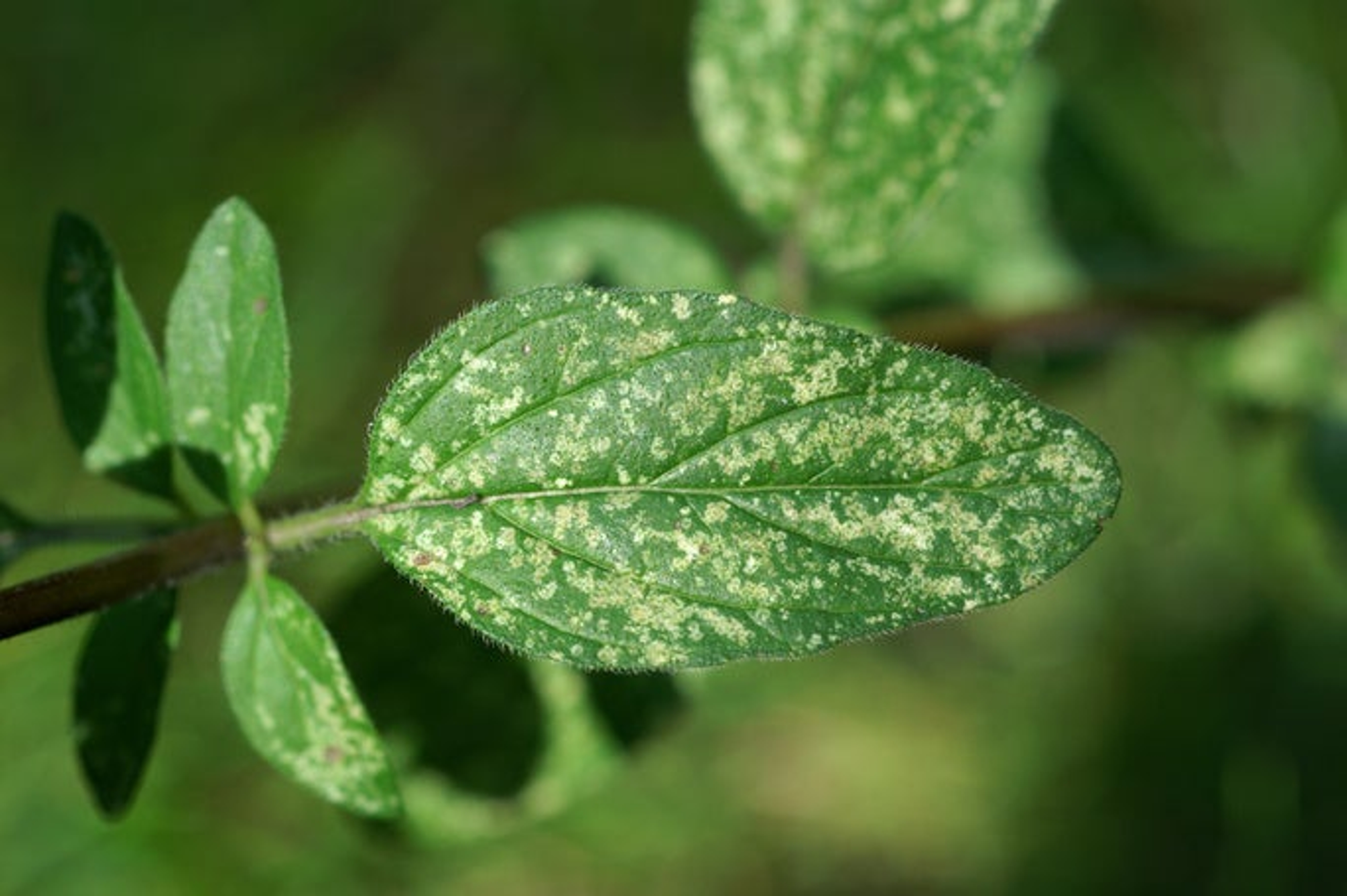
Identification (adults): There are several species of these eight-legged mites that damage plants, but two-spotted spider mites are the most common. The mites are tiny, but populations can explode quickly. Infested leaf bottoms become covered with tiny, pin-point mites (1 mm or less) that create small webs. Leaf tops appear to have tiny yellow or white spots where the mites have sucked away the leaf juices. If you suspect a plant has mites, do the paper test. Take some clean paper, hold it beneath the leaves, then tap the leaves onto the paper. If tiny specs fall and start crawling around, then your plant has spider mites. Life cycle speed depends on temperature (80 degrees F is optimal) and spans from five to twenty days, from egg to reproductive adult.
Damage and Location: As with white flies, spider mites tend to favor leaf undersides, but they may also cover more tender leaves and stem tips. The tiny sucking insects destroy leaf tissue by sucking the leaf cells dry, one by one. Bad infestations can cause leaf drop and severe plant decline.
Management: Once you notice spider mite damage, your infestation is probably already significant. Start by removing the most infested leaves. Next, spray, wash, and wipe the stems and leaves thoroughly. (Mites and water don’t mix, because they often develop a debilitating fungal disease under moist conditions!) I also recommend removing and replacing the top inch of potting soil, where mites may be, and wiping down the pot to kill any that might have strayed. Finally, spray the plants with insecticidal soap or Neem oil. Continue to do the paper test, clean, and spray until all signs of mites are gone.
5. Mealybugs

Identification (eggs, larvae, and adults): Mealybug egg masses cannot be missed. They are cottony, white, and tend to be found in stem and leaf crevices and on tender tissues. Nearly invisible nymphs, called crawlers, emerge from the eggs and can crawl for several feet to find another spot on the plant to dine or to find a new plant altogether. The crawlers develop into adult mealybugs (3-5 mm), which are oval, cottony, white, and easily smashed (their insides are orange-yellow). They are able to complete a life cycle in six weeks to two months.
Damage and Location: Mealybugs are very efficient sucking insects that will quickly suck the life out of a plant if left unchecked. Populations rapidly grow, and they also spread from plant to plant quickly. They can be found all over infested plants, but they often group and feed in protective leaf and stem joints.
Management: Serious attention and thorough care must be given to overcome a mealybug infestation. Start by separating the infested plants from healthy ones. Crawlers are what make management difficult. They are almost impossible to see, but they can crawl several feet, so start by cleaning plants, containers, and all surfaces near plants if you find them. Refreshing surface soil (1 inch) is also recommended. Finally, spray the plants—starting with the leaf undersides and stem and leaf crevices. A solution of 10-25% isopropyl alcohol (1/4 cup of isopropyl alcohol to 3/4 cup water and shake to combine) works well. Avoid direct sunlight just after treatment, because leaf burn can occur. Commercial mealybug sprays are also available. Be thorough, repetitive, and diligent with treatment and you can overcome mealybugs.
Note: Applying two-sided tape to the rim of plant pots can trap crawlers and keep them from leaving a plant.
6. Armored and Soft Scale
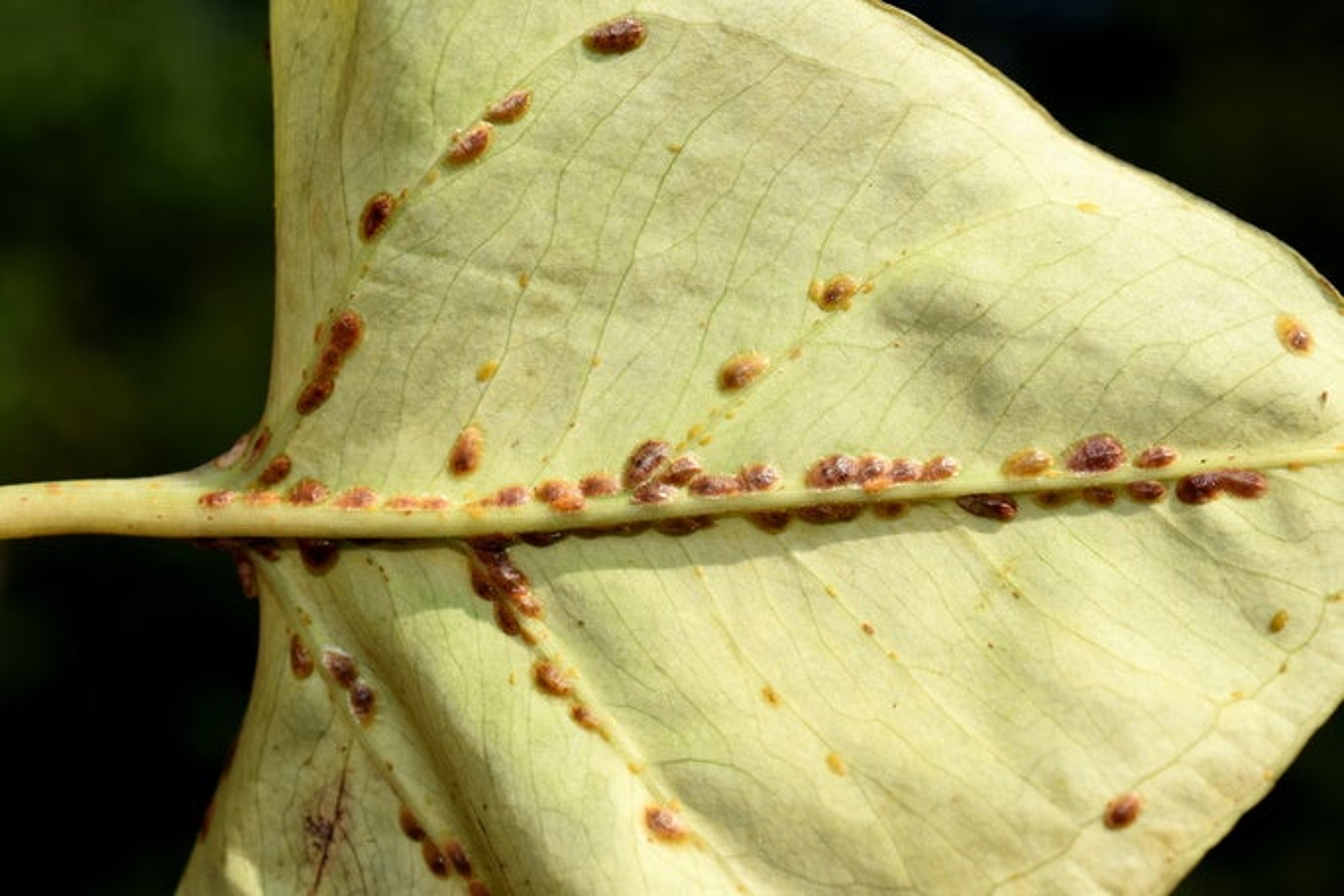
Identification (eggs, larvae, and adults): Scale insects are easily identified. They have soft (soft scale) or hard (armored scale) shield-like covers that protect the bugs underneath. Armored scale is less mobile and infestations often occur in large numbers—the tough exteriors can make them more difficult to kill. Soft scale is similar to armored aside from their softer exteriors. Their life cycles and patterns of infestation are similar to that of mealybugs. There are many kinds of scales that differ in appearance, most are naturally camouflaged with the plants they infest. Life cycle times vary.
Damage and Location: These sucking insects can exist all over plants, but they tend to favor stem tissue. The armed adults and crawlers such the water and nutrients from stems and leaves, which damages plant growth and can even kill plants in severe cases.
Management: Scale is tough to remove, but it can be done. Once you see it, start by cleaning all surfaces as you would for mealybugs to stop their crawlers. Next, clean off the plant, and then use a fine, sharp tool to scrape off all scale adults without damaging the stems. Wipe the plants off when you are done. Severely infested stems should be cut off. Finally, wash plants down with insecticidal soap. Systemic insecticides can be applied if you have a severe case on a prized plant. Preventative applications of horticultural oil spray can also be applied when crawlers are most active, in late winter or early spring, and then again in early summer. Double-sided tape traps can be applied to pots, as suggested with mealybugs. Monitor your plants regularly to stay on top of any scale infestation and repeat management steps as needed.
Sticky Traps to Monitor House Plant Pests
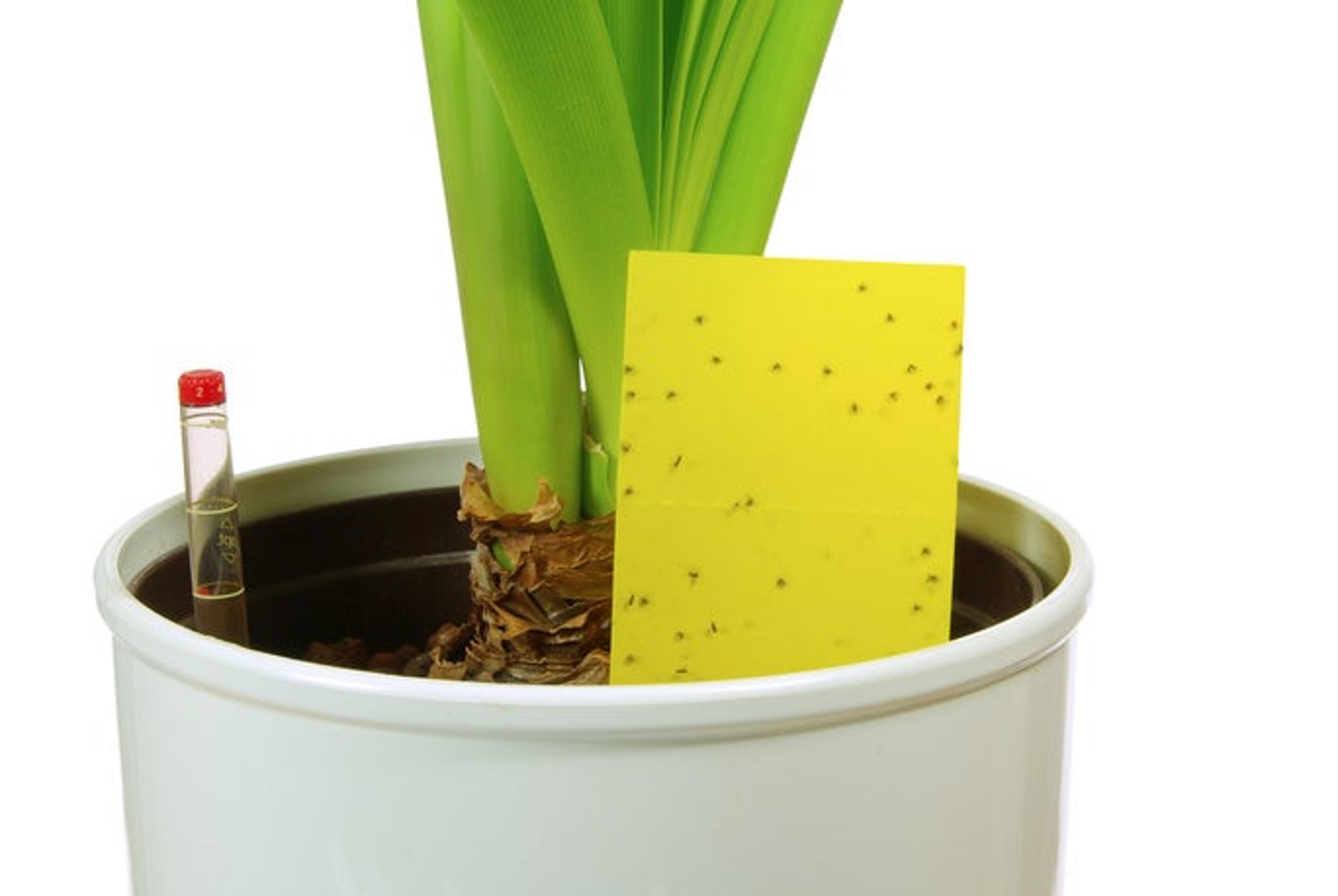
House plant pests that fly, such as white flies, fungus gnats, and aphids, are attracted to yellow sticky traps. If you have lots of plants, it pays to place these traps around your plants to help determine whether any of these pests are present—the more pests on the trap, the worse the problem. These traps also help to kill flying adults. Yellow sticky traps can be purchased online or at most garden centers.






